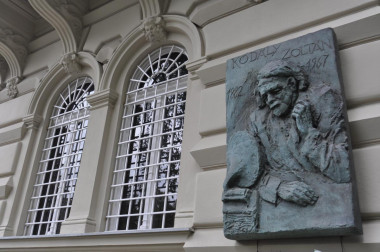Zoltán Kodály’s activity as ethnomusicologist developed parallel to his work as a composer, and fertilized it from 1905 onwards. Later folk music achieved an eminent place in Kodály’s music pedagogical concept as well.
He recognized that genuine Hungarian folksong can only be found at its original source, in the oral tradition of village people. His first folksong collecting tours led him to the Galanta region (North-West Hungary, today in Slovakia) where he spent his childhood, and where he received his first unconscious but deep impressions in folk music. A selection from his first findings was published in the academic periodical, Ethnographia in 1905. He defended his doctoral thesis, The Strophic Structure of the Hungarian Folksong in 1906.
Béla Bartók also became interested in folk music collecting at the same time. They shared the tasks; Kodály mostly collected songs at the northern part of the Hungarian language territory, but he also went to Transylvania after 1910, and he visited Hungarian villages in Bukovina in 1914. During the work they recognized the importance of comparative research of folk traditions: in connection with the neighbouring peoples’ folk music the recognition of the differences was important, then establishing the common characteristics between Hungarian songs and those of related peoples.
The two composer-ethnomusicologists published a little collection of folksong arrangements with piano accompaniment to popularize the peasant songs among musically educated people in 1906. They published smaller studies and selections of tunes but the plan for a real academic collection could only be formed in the 1910s, when they felt the material is large enough for such a publication. For this reason a good musical classifying system had to be worked out. A useful example was found in the melody ordering of the Finnish ethnomusicologist, Ilmari Krohn. In 1913 The Plan of The New Universal Collection of Folksongs was presented at the Kisfaludy Society. Unfortunately the lack of support and World War I made it impossible to realize the plan. In the coming years Kodály enriched ethnomusicology with some important studies.
In 1920 according to the Trianon Treaty Hungary lost regions which had been very rich in folk tradition. The new borders made folksong collecting expeditions impossible for the researchers. This inspired them to publish a selection of 150 Transylvanian songs with Kodály’s Introduction in 1923. Kodály himself did not give up the field-work: he continued to enrich his collection mostly in Trasdanubia until 1950.
In 1934 Béla Bartók started to work officially at the Hungarian Academy of Sciences on the revision of folksong transcriptions and the systematization of the collection. Kodály undertook the search for historical materials and manuscripts in archives and libraries. This fact well demonstrates the difference between their personalities as researchers. In general, Bartók extended his interest geographically towards other nations’ folk music, while Kodály wanted to give a historical perspective to the roots of Hungarian folk music. His fundamental study on Hungarian Folk Musicwas published in 1937. In this book he presented a wide scope of the topic based on material collected by himself and other co-workers and he placed Hungarian folk music in historical and international contexts.
After Bartók’s emigration (1940) Kodály continued the work at the Academy of Sciences. He found co-workers to prepare the Complete Edition of Hungarian Folk Music (Corpus Musicae Popularis Hungaricae), and the first volume, Children’s Games, edited by György Kerényi, was already published in 1951. The Preface was written for this as well as for further volumes until 1967 by Zoltán Kodály. The Folk Music Research Group of the Hungarian Academy of Sciences was officially founded in 1953. From 1951, in the frame of the Department of Musicology at the Academy of Music would-be ethnomusicologists were trained under the leadership of Kodály.
It showed the international reputation of Zoltán Kodály’s work as well as the results of Hungarian ethnomusicology in general that professor Kodály was appointed president of the International Folk Music Council (1961), and in 1964 the IFMC Congress was held in Budapest.
References / Recommended studies in English:
Kodály, Zoltán: Folk Music of Hungary. (Revised and enlarged by Lajos Vargyas. Budapest: Corvina, 1960, 1982. (It was also published in German)
Selected Writings of Zoltán Kodály. Budapest: Corvina, 1974.
Kodály, Zoltán: The Development of Musical Folklore (1923). Bulletin of the International Kodály Society.Centenary Issue. 1982/2. p.32.
Kodály, Zoltán: Preconditions of Comparative Folk Tune Research (1956). Bulletin of the International Kodály Society. Centenary Issue. 1982/2. p.33.
Kodály, Zoltán: Opening Address at the Lecture Session of the Folk Music Research Group of the Hungarian Academy of Sciences on the occasion of 20th anniversary of Bartók’s death. Bulletin of the International Kodály Society. Centenary Issue. 1982/2. p.34.
Martin, György: Bartók, Kodály and Folk Dance Research. In: F. Bónis, E. Szőnyi, L. Vikár (eds.): International Kodály Conference Budapest 1982. Budapest: Editio Musica Budapest, 1986. pp. 259-262.
Szalay, Olga: Kodály, the Ethnomusicologist and his Scientific Workshop 1905-1967. Academic dissertation. Jyväskylä: University of Jyväskylä (Finland), 2003.
Tanimoto, Kazuyuki: Kodály, the Ethnomusicologist. Bulletin of the International Kodály Society. 1983/1. pp. 22-24.
Vargyas, Lajos: Kodály, the Scholar. Bulletin of the International Kodály Society. 1983/1. pp. 18-22.
Vikár, László: Zoltán Kodály, the Folklorist. Bulletin of the International Kodály Society. 1983/2. pp.13-17.
Vikár, László: Kodály, the Musicologist. Bulletin of the International Kodály Society. Vol 20, no 2, 1995 Autumn. pp. 21-26.
Source: the website of the Kodály Institute http://kodaly.hu/kodaly_en_kodaly/ethnomusicology-107385


